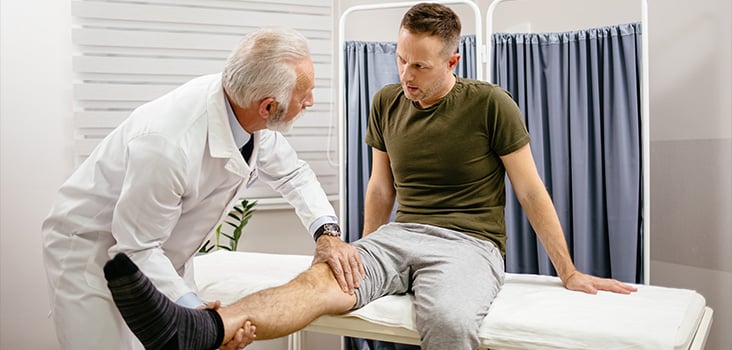
Avoid Bending to the High Cost of Knee Injuries
Knee injuries and lost work time
Knees have been called a “triumph of design,” but they often get little attention in the workplace or in life until more advanced years and the onset of arthritis.1 Knees probably aren’t a hot topic at the morning safety meeting because they represent fewer than 6% of all nonfatal injuries (in 2020) and only about 35% of injuries to the lower extremities.2
The incidence of knee injuries may not raise a red flag, but their impact on days away from work (DAFW) is definitely worth considering because knee injuries were second only to shoulder injuries in lost work time in a 2020 assessment.3
Select Body Part Injured
(Median Days Away from Work)
- Head (4)
- Back (9)
- Foot (13)
- Body System (13)
- Wrist (15)
- Knee (18)
- Shoulder (28)
Knee injuries at work can arise from stopping suddenly or twisting when in fast motion, putting too much pressure on the knees, excessive kneeling, or sheer overuse. In construction, for example, roofers often suffer from knee injuries due to spending a large amount of time kneeling on sloped rooftops. “Several ergonomic studies have identified kneeling as a potential risk factor for knee injuries and disorders.”4
Ten industries have 94% of knee injuries
In 2020, there were 66,650 knee injuries overall; about 78% were in the service sectors and 22% were in goods-producing sectors. The top five industries for knee injuries represented 69% of the total and the top 10 industries had 94% of all knee injuries in 2020.5 Incidence of knee injuries is shown below:
- Health care and social assistance (13,790)
- Retail trade (9,560)
- Transportation and warehousing (9,370)
- Manufacturing (6,930)
- Construction (6,340)
- Leisure and hospitality (5,670)
- Wholesale trade (3,660)
- Administrative, support, waste management and remediation services (3,580)
- Real estate, rental, and leasing (1,760)
- Natural resources and mining (1,700)
The average workers’ compensation claims cost for knee injuries has been reported as nearly $35,000 in 2019 and 2020.6
Knee anatomy and causes of injuries
The knee is formed by two leg bones – the tibia or shin bone and the femur or thigh bone – and the kneecap or patella. The tibia and femur are covered by cartilage, which acts as a shock absorber, and are held together by muscles, ligaments, and tendons. The muscles involved are the quadriceps in front of the thighs and the hamstrings in the back of the thighs. Tendons connect the muscles to the bone, and ligaments are elastic bands of tissue that connect bone to bone. Some ligaments on the knee provide stability, while others limit forward and backward movement of the tibia or shin bone.7
Ligaments and muscles can become sprained or strained by a blow or sudden twist to the knee. Cartilage can be torn, and frequently is, with sprains. Tendonitis, or inflammation of the tendons, occurs with overuse. Tendonitis of the patellar tendon is called jumper’s knee and results from hitting the ground with force.8 Commercial drivers can experience jumper’s knee if they hit the ground hard with locked knees when exiting the cab of their vehicle. They have been advised to “lessen the impact by landing with softened knees,” or bending at the knees slightly to absorb the impact when hitting the ground.9
Protecting knees from injury
Knees are vital to work-related motion and also to general well-being. Taking steps to protect knees can help promote their functional longevity. It’s a challenge. The knee is “one of the largest and most complex joints of the body,” and “also one of the joints most prone to pain, injury, and many forms of arthritis,” says the Arthritis Foundation.10
Tips the foundation offers to maintain healthy knees include:
- Get regular physical activity
- Maintain a healthy weight
- Avoided repetitive pounding/pressure on knees (such as in jogging)
- Treat injuries promptly
- Eat a healthy diet, with ample calcium and vitamin D
- Avoid smoking
- Use good posture
- Select quality footwear
Individuals who weigh more than what is recommended as healthy may be able to take as much as 40 pounds of force off their knees by losing just 10 pounds. In addition, converting fat to muscle may help reduce inflammation.11
How Concentra can help
The best way to deal with knee injuries in the workplace is to prevent them from the start – or prevent the early signs of wear and tear from becoming a full-blown, painful injury through an intervention by a rehabilitation professional. Concentra® can help on both counts.
As part of pre-employment testing and for return-to-work evaluations, Concentra conducts human performance evaluations (HPEs) for job candidates of physically demanding jobs (or employees returning to work after an extended absence). HPEs will utilize functional tasks such as lifting, carrying, pushing/pulling, crawling, kneeling, and squatting to determine if an individual can perform the essential functions of the job safely. To preserve general knee health, Concentra recommends strengthening and flexibility exercises, wearing knee pads, and avoiding jumping from elevated surfaces onto hard surfaces.
Concentra Onsite Health offers Early Symptom Evaluation, both in person and via telemedicine for onsite clients. Research has demonstrated that knees can be effectively evaluated using telemedicine.12
Occupational health guidance, such as Concentra provides, can help ensure that your workforce avoids costly knee surgery and enjoys work and life to the fullest.
NOTES
- “A Flawed Masterpiece: Human knee evolved in lockstep with osteoarthritis, study says,” by Clea Simon. The Harvard Gazette. April 7, 2020.
- Injuries, Illnesses, and Fatalities. Number of nonfatal occupational injuries involving days away from work by industry and selected parts of body affected by injury or illness, private industry, 2020. U.S. Bureau of Labor Statistics. November 3, 2021.
- Work Injuries and Illnesses by Body Part. National Security Council Injury Facts. Accessed October 3, 2023.
- Breloff SP, Dutta A, Dai F, et al. Assesssing work-related risk factors for musculoskeletal knee disorders in construction roofing tasks. Applied Ergonomics November 2019;81:102901.
- Injuries, Illnesses, and Fatalities. Number of nonfatal occupational injuries involving days away from work by industry and selected parts of body affected by injury or illness, private industry, 2020. U.S. Bureau of Labor Statistics. November 3, 2021.
- “What is the Average Compensation Payout for Knee Injury Benefits,” by Susan Vanderweert. Farrin Law Blg. July 28, 2023.
- Knee Pain and Problems. Johns Hopkins Medicine. Accessed: October 3, 2023.
- Knee Pain and Problems. Johns Hopkins Medicine. Accessed: October 3, 2023.
- “How to combat back, shoulder, and knee pain as a truck driver.” Trucking News and Trends. April 6, 2021.
- “10 Tips for Healthy Knees and Strong Joints as You Age,” by Mary Anne Dunkin. Arthritis Foundation. February 16, 2023.
- “Easy Ways to Protect Your Knees,” by Paul Frysh. Medically reviewed by Brunilda Nazario, MD. WebMD. April 1, 2022.
- Vomer II RP, York E, Rayghan LS, et al. Telemedicine Examination of the Knee. Cureus. April 1, 2023; 15(4):e37009.



